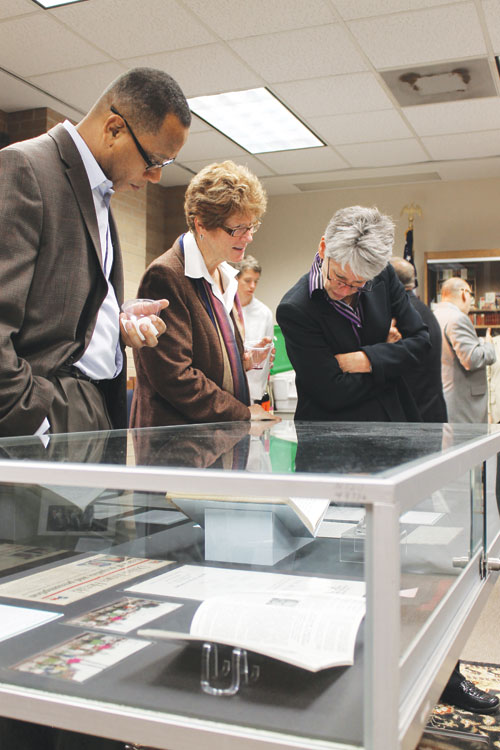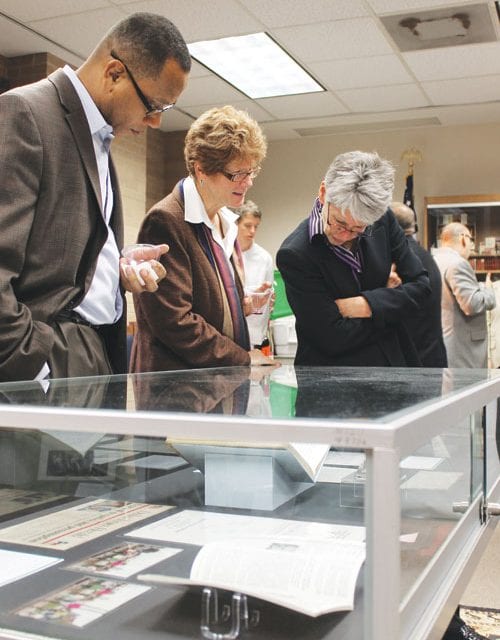Items from the Resource Center’s collection of artifacts have been catalogued, become cornerstone of school’s LGBT Studies Program

HISTORY BUFFS | People view an exhibit at UNT’s Willis Library about the history of the LGBT community in Dallas during an opening reception on Oct. 17. The exhibit is on display through the beginning of January. (David Taffet/Dallas Voice)
DENTON — After Hugh Calloway and his partner, Thanh Min Nguyen, were attacked in Reverchon Park in October 1991, Calloway kept a diary. Opened to show two pages from it, poignantly detailing the tragedy, the diary is displayed on the fourth floor of the Willis Library at the University of North Texas. The page ends with an entry written a few days after the attack.
Calloway writes about a Dallas Times Herald reporter who contacted him because she was doing a story on “gay people who go to parks and other places to meet sexual partners.” The reporter’s angle focused on cruising rather than a murder, even though Calloway and Nguyen were in Reverchon eating hamburgers when they were attacked. In those days, a story on men having sex in the park was bigger than a story on hate crimes against the gay community.
Two letters also are displayed with the diary. One is from Calloway to Frederick Kirby, the assailant who is serving a 20-year sentence for killing Nguyen. He died from injuries sustained in the attack.
“I don’t hate you, but I know what you are — a hate-filled psychopath,” Calloway wrote.
Next to that letter is one from Kirby in which he repeatedly asked Calloway for forgiveness and comes out to him in neatly printed words. The letters and diary are part of the Phil Johnson Collection that the Resource Center donated to UNT in 2012.
Johnson, a local collector of LGBT memorabilia, gave his accumulation to the Resource Center, and it grew as other items, including the diary and letters, were added to it. This is the first exhibit mounted from that collection.
Martin Halbert, dean of libraries, called it an “incredible collection that will become the cornerstone of our LGBT studies program.” He said the library has been working to organize the collection to provide scholarly access.
The collection has already been used. In gathering background information for the upcoming film The Dallas Buyers Club, the production team relied on pictures and T-shirts from the collection to see how the gay community dressed at the time and what Oak Lawn looked like in the late ’80s and early ’90s when the film is set. So valuable were the items to the look and feel of the film, UNT’s Resource Center Collection gets a credit.
Amanda Montgomery and Sam Ivie, both UNT librarians, were responsible for cataloguing the items.
Montgomery said they began with preparation meetings to find ways to sort through the boxes filled with a variety of photographs, clippings, publications, T-shirts and memorabilia.
“Then we put together our own inventory,” Ivie said.
The items are now sorted into folders stored in 582 boxes. An online catalog of the items is 300 pages long. Montgomery said some items were sent to the rare books librarian at UNT to scan. Clippings and other more perishable items were wrapped in acid-free folders with tissue paper, and boxes will be stored in the school’s new climate controlled storage facility.
Researchers can access the collection by searching online for particular items. Montgomery said if someone knows what he wants to see, to call ahead with the box and folder number and she’d have those pieces ready. For a small fee, the library would arrange to scan and email items to someone not able to get to Denton.
Ivie said he learned a great deal about the Dallas LGBT community.
“The groups, the reason for their inception, the founding of the center,” he said. “Lots of tragic things.”
He said he was moved by the personal accounts.
Montgomery said she saw the love the community showed for each other.
“I learned how AIDS was being handled in Dallas,” she said.
One group of pictures from Resource Center stuck in her memory.
“The staff in Halloween costumes,” she said. “Having fun in the face of tragedy.”
Although most of the Resource Center artifacts are archived, some pictures remain unidentified. That project is ongoing. In addition, pictures from Dallas Voice will be catalogued, and a grant has been written to digitalize 30 years of the newspaper and other publications it has produced over the years.
But UNT hopes to expand beyond there to become the LGBT archives for the South and is looking for collections from throughout the region.•
For more information about the archives, visit TinyURL.com/LGBTarchives.
This article appeared in the Dallas Voice print edition October 25, 2013.


